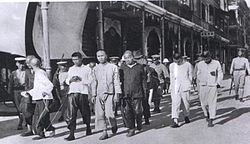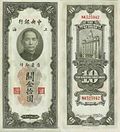Nationalist government
The Nationalist Government (Mandarin: 國民政府, Romanized: Guómín zhèngfǔ), simply known as the Nationalist Government of the Republic of China (Mandarin: 中華民國國民政府, Romanized: Zhōnghuá mínguó guómín zhèngfǔ) was the ruling government of mainland China and the island of Taiwan from 1925 until 1949, after the end of the Chinese Civil War.
Republic of China 中華民國 | |||||||||||
|---|---|---|---|---|---|---|---|---|---|---|---|
| 1925–1949 | |||||||||||
| Anthem: | |||||||||||
 Land controlled by the Republic of China in 1945 shown in dark green; uncontrolled claims shown in light green. | |||||||||||
| Capital | |||||||||||
| Official languages | Standard Chinese | ||||||||||
| Demonym(s) | Chinese | ||||||||||
| Government |
| ||||||||||
| De-facto leader[2] | |||||||||||
• 1926–1948 | Chiang Kai-shek[2] | ||||||||||
| Premier | |||||||||||
• 1928–1930 (first) | Tan Yankai | ||||||||||
• 1947–1948 (last) | Zhang Qun | ||||||||||
| President | |||||||||||
• 1928 (first) | Tan Yankai | ||||||||||
• 1943–1948 (last) | Chiang Kai-shek | ||||||||||
| Legislature | National Assembly | ||||||||||
| Control Yuan | |||||||||||
| Legislative Yuan | |||||||||||
| History | |||||||||||
• | 1 July 1925 | ||||||||||
| 1926–1928 | |||||||||||
• Reset in Nanjing | 18 April 1927 | ||||||||||
| 1927–1936, 1946–1950 | |||||||||||
| 7 July 1937 – 2 September 1945 | |||||||||||
• Admitted to the United Nations | 24 October 1945 | ||||||||||
• Retrocession of Taiwan and the Pescadores | 25 October 1945 | ||||||||||
| 28 February 1947 | |||||||||||
| 25 December 1947 | |||||||||||
• | 20 May 1948 | ||||||||||
| Currency |
| ||||||||||
| ISO 3166 code | CN | ||||||||||
| |||||||||||
Led by the Nationalist (KMT) or Kuomintang party, it was officially formed on the 1 of July 1925 in Guangzhou. After the Northern Expedition, the KMT would overthrow the Beiyang government of the Republic of China. Soon after the Chinese Civil War would begin in 1927, in 1937 the Second Sino-Japanese War began when the Empire of Japan invaded. The war would end with a Chinese and Allied victory. The civil war restarted not long after and then the government would fall in 1949.[3][4]
Nationalist Government Media
National-Anthem-of-the-Republic-of-China-1942-recording
National Flag Anthem*
War Declaration against Japan by the Chongqing Nationalist Government on 9 December 1941
A Vought O2U Corsair observation aircraft, flown by the Chinese Nationalist Air Force. The type of aircraft was used extensively during anti-communist campaigns prior to the 2nd Sino Japanese War
References
- ↑ Lloyd E. Eastman (1991). The Nationalist Era in China, 1927-1949. Cambridge University Press. pp. 3, 50. ISBN 9780521392730.
Under Chiang's aegis, the Nationalist government in Nanking transformed into a military dictatorship"; "The military continued to hold ultimate power... The regime was a dictatorship built on and maintained by military power.
- ↑ 2.0 2.1 Lloyd E. Eastman (1991). The Nationalist Era in China, 1927-1949. Cambridge University Press. pp. 20–21. ISBN 9780521392730.
It would be a mistake, however, to devote exclusive attention to the structure of the Nationalist government or to the formal relationship between, say, the Executive Yuan and the Legislative Yuan. For, regardless of the formal positions that Chiang Kai-shek held in the party, government or army, he wielded ultimate authority over the regime as a whole.
- ↑ "Taiwan in Time: The great retreat - Taipei Times". www.taipeitimes.com. 4 December 2016. Retrieved 7 March 2025.
- ↑ "Chinese Civil War (1928-1949)".







